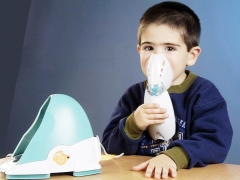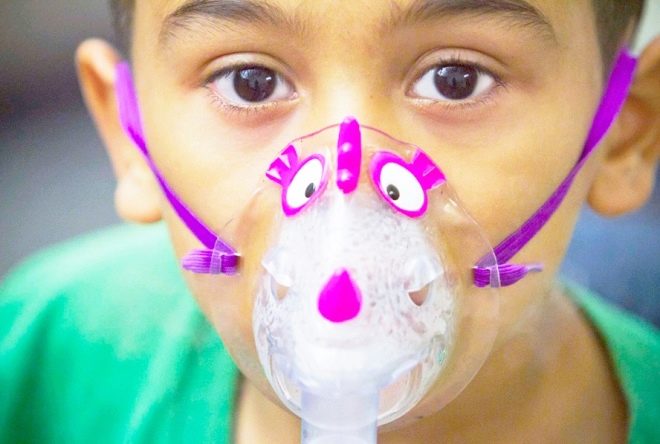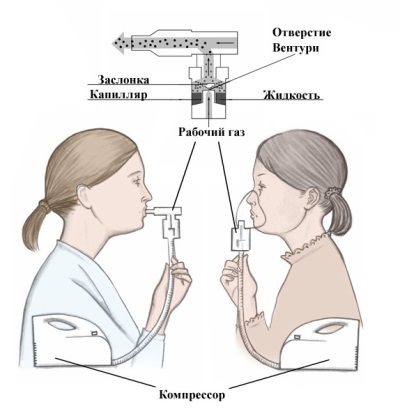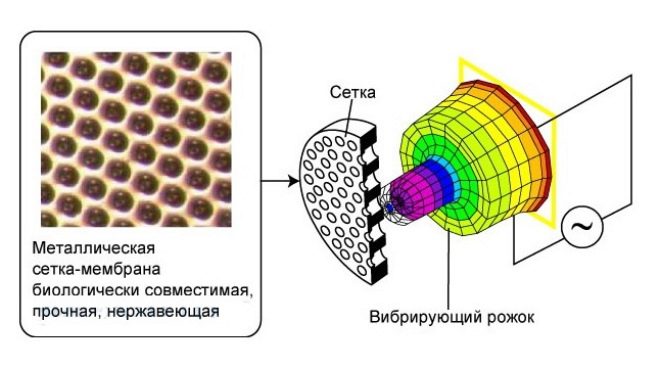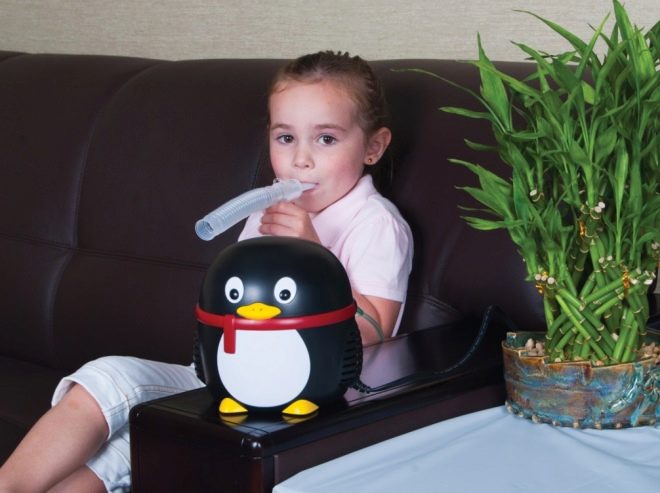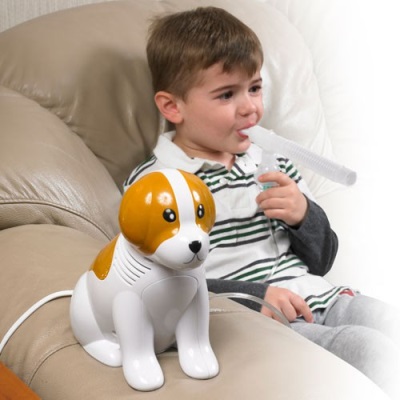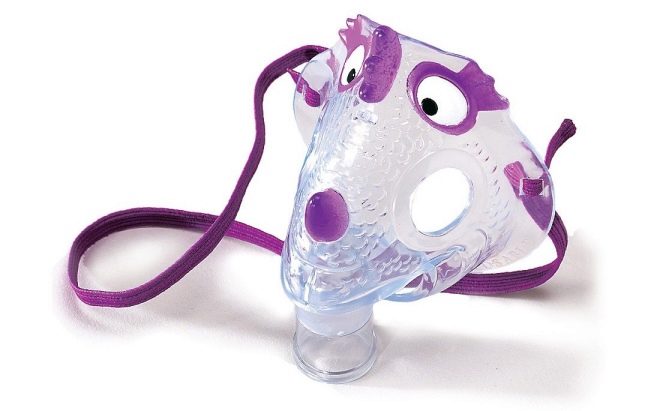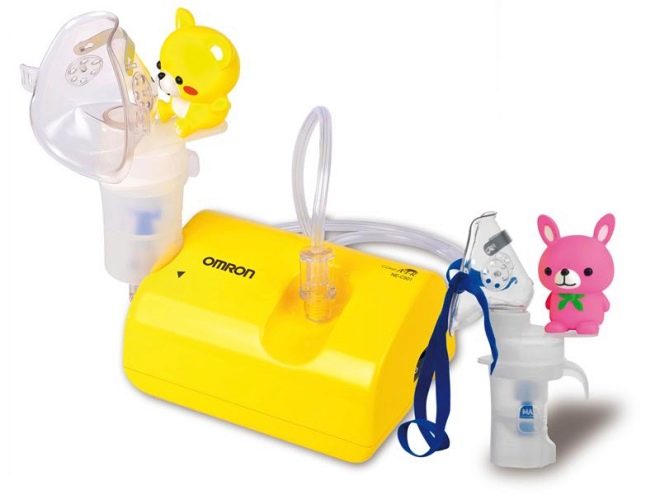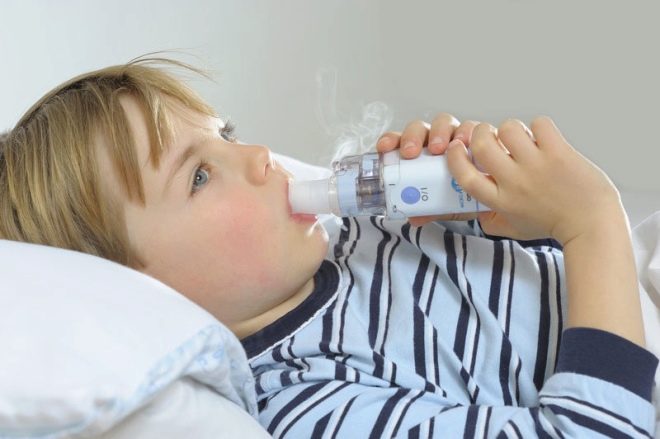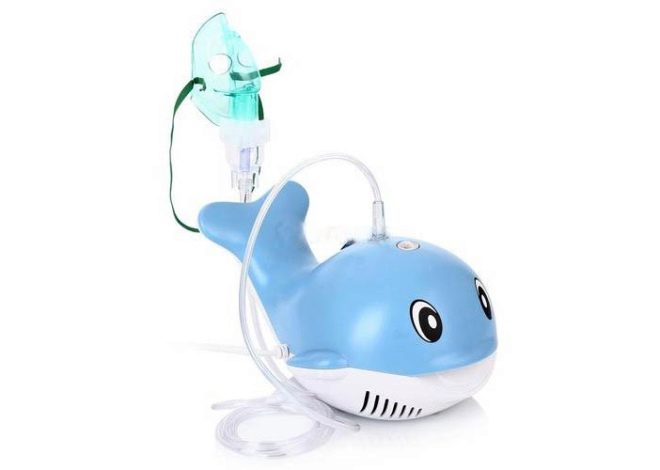Nebulizer for children
Many young mothers are interested in buying a nebulizer these days, because such a device allows you to quickly treat colds in young children without any extra medication at home. However, before purchasing it is worth exploring in detail what the device is used for, how it is and how to use it correctly.
A nebulizer is an apparatus in which a liquid substance (drug solution) is converted into an aerosol. Its small particles enter the respiratory organs and are deposited on the walls of the respiratory tract. It was the formation of an aerosol that looked like fog and gave the name to the device (in Latin the fog sounds like nebula).
Features:
- Most often, the nebulizer is used in children for the treatment and prevention of respiratory diseases. Also, this device can be used for nervous diseases (problems with sleep, depression, asthenia) or endocrine problems (diabetes, obesity).
- The nebulizer purchased for a nursing baby includes a breathing mask and mouthpiece, as well as a special tip. Ultrasonic and compression devices are usually sold with nozzles for the whole family.
- The children's nebulizer is often presented in the form of cute toys, so the treatment becomes an interesting and exciting process for the baby. A child with asthma or allergies will happily agree to “play” with an inhaler in the form of a cow or train.
- Virtually any nebulizer will help in the treatment of bronchitis and tracheitis, as well as bronchial asthma. Diseases such as laryngitis, pneumonia or pharyngitis can not be treated with every inhaler, and only certain models can be used for sinusitis and rhinitis.
Kinds
Depending on the structure of the device and its operation, these types of nebulizers are distinguished:
Nebulizer view | Principle of operation | pros | disadvantages |
Compressor | To create an aerosol cloud, a compressor is used that delivers air flow through the chamber with the medicinal preparation in liquid form. | The most common type. Able to dispense most drugs. It is possible to obtain the smallest particles of drugs that can get into the remote parts of the lungs. Especially recommended for frequent acute respiratory viral infections and bronchitis, as well as for bronchial asthma and bronchiectasis. The device is very easy to use. | Such a nebulizer is large. During operation, the device is very noisy. Inhalation can be carried out only in a vertical position. |
Ultrasonic | The aerosol cloud is created under the influence of high-frequency ultrasound, affecting the solution of medicines | It can be used at different body position of the child. There are portable models on batteries that can be taken on a trip. The operation of the device is not very noisy. Especially recommended for colds. | Ultrasound can destroy some drugs, in particular, solutions with an antibiotic, a hormonal drug, or mucolytics. We have to spend additional funds to buy special cups for medicinal solutions. |
Electronic mesh (also called a mesh nebulizer) | To create an aerosol cloud, the solution of the medicine is passed through a vibrating membrane, in which there are tiny holes | This type is called universal and most effective. During operation, the nebulizer drugs are not destroyed. The device works silently. Inhalation can be performed at any position of the body, so the device is indispensable in infancy. After inhalation does not remain unused drug solution. Most often used for asthma and bronchitis. | It is relatively expensive. |
Jet nebulizer device:
The device of the ultrasonic nebulizer:
The device nebulizer:
Why help with respiratory infections?
Most often, the nebulizer is used for coughing and running nose, although the use of an inhaler for these purposes is often not justified. Also this device can be effective in adenoids. Sometimes it is simply indispensable, for example, in case of bronchitis or laryngitis, since the use of a nebulizer helps to quickly deliver various medications directly to the respiratory tract of the child.
The medicine transformed into an aerosol almost without loss passes through the nasal cavity, the trachea and the bronchi, providing a quick therapeutic effect. Inhalation eliminates dry throat and alleviates coughing, promotes the removal of sputum, and also activates blood flow, thus speeding recovery.
Contraindications
It is strictly forbidden to pour the oil solution of drugs into the nebulizer, since small droplets of oil together with water vapor will get into the bronchi, causing oil pneumonia. To treat this pathology is very difficult.
In addition, the nebulizer is not advised to place herbal decoction, since such a liquid can clog the mechanism of the device.
What is the treatment?
Depending on the size of the particles formed in the nebulizer aerosol, the drug will settle in a certain part of the respiratory tract. For example, particles less than 2 microns will fall into the alveoli, with a size of 2 to 5 microns, the drug will settle in the bronchioles, bronchi and on the walls of the trachea. If the particle size is from 5 to 10 microns, such a drug will remain in the trachea and larynx, and a size greater than 10 microns will not allow the liquid medication to fall below the oropharynx and pharynx.
Sprayed into small particles medications are evenly distributed on a certain part of the respiratory system, which causes a stronger and more lasting effect. Simultaneous ingestion of water vapor along with the drug will be beneficial for mucous membranes. It stimulates the production and secretion of mucus, as well as enhances blood circulation and accelerates metabolic processes.
How to make inhalation?
Pouring the solution into the nebulizer tank, the device is closed and a mask or mouthpiece is connected to it (this depends on the model of the device). When the procedure is completed, all parts are washed with warm water and disinfected in a 3% peroxide solution for 30 minutes, then dried.
If inhalation is carried out in diseases of the upper respiratory system, it is recommended to breathe through your nose through a mask. Also, the mask should be used for diseases of the trachea, with the need to breathe through the mouth. If you need to deliver the drug in the lower respiratory tract, the procedure is carried out through a tube.
The video of the Union of Pediatricians of Russia tells about important nuances and rules for using inhalers.
How to breathe: the best recipes solutions
The composition of the solution | What helps | Application features |
Purified Mineral Water, Sodium Chloride | From a cold, "wet" cough, laryngitis, adenoids | The frequency of the procedures - 2-4 times daily. Inhalation is carried out through a mask. |
ACC 1 ml injection Saline 1 ml | From "dry" cough | At 2-6 years of age, for one inhalation use 1-2 ml of medication and the same amount of saline. 1-2 procedures are performed daily. Duration of up to 10 days. It is not recommended to combine with antibiotic treatment. |
Ambrobene or lazolvan 1 ml Saline 1 ml | From diseases of the respiratory system with difficult to separate viscous sputum | Until the age of two, 1 ml of medication is used, for children over 2 years old - 2 ml per procedure. Inhalation spend no longer than 5 days. Do not combine with treatment with antitussive drugs. |
Pertussin 1 ml Saline solution 2 ml | Cough with tracheitis and bronchitis, as well as with whooping cough | Conduct children under 10 years. |
Interferon 3 ampoules Saline 30 ml | From viral rhinitis | Before the procedure, the solution is heated, but not more than up to + 37 °. Inhalation spend 2 times a day. |
Fluimucil 1/4 bottle | From angina of a bacterial nature | The procedure is performed twice a day. An open bottle of antibiotic stored in the refrigerator for up to 24 hours. Before inhalation, the medication should be heated to room temperature. |
Dekasan 2 ml Saline 4 ml | From laryngofaringitis and angina of a bacterial nature, as well as from adenoids | The procedure is carried out 1-2 times a day for a maximum of 5 days. |
Miramistin 1 ml Saline solution 2 ml | For purulent forms of respiratory tract infections | Inhalations are carried out three times a day. |
Tussamag 1 ml Saline 3 ml | From unproductive cough | Procedures are prescribed for children from 1 to 5 years up to 3 times a day. |
1% alcoholic solution of chlorophyllipt, diluted in saline solution 1:10 | From the common cold caused by staphylococci | For one procedure, use 3 ml of the resulting solution. Inhalation should be carried out three times a day. |
Berodual 10 drops (children under 6 years) Saline 3 ml | Spasms of the respiratory organs and asthma attacks | Inhalations are shown up to 3 times daily. |
Ventolin nebuli 1 ampoule | From attacks of bronchial asthma | Each ampoule of the drug is a ready solution of salbutamol for inhalation. Procedures are carried out three times a day. |
Astalin 1 ampoule | From attacks of bronchial asthma | Each ampoule contains salbutamol mixed with saline, so this is a ready solution for inhalation. The dosage may vary depending on the severity of the attack - if the case is mild, it is permissible to use half of the ampoule, while it can be diluted with saline. |
How many minutes to breathe a nebulizer?
The smaller the child, the less the procedure should last. It is not necessary to carry out inhalation for longer than 7-10 minutes, otherwise the next time the child can flatly refuse such treatment. In this case, it is believed that the most effective inhalation, carried out before bedtime.
Is it possible to give a nebulizer at a child's temperature?
If the child's body temperature is elevated, the use of a nebulizer is not recommended, as this can cause an additional rise in temperature. In addition, it is not advised to conduct inhalation for 20 minutes after a meal, as well as to talk during the procedure.
It is permissible to perform procedures using a nebulizer at elevated temperature only if the child is asthmatic, he has bronchospasm, and his body temperature is less than + 38 °. It is also allowed to conduct steam inhalation solutions from room temperature, if mineral water is used.
Is it possible to carry out the procedure for children under one year?
The use of a nebulizer is allowed from the first days of life. Such a device will safely and fairly quickly help cure respiratory diseases, even when the child still does not know how to take deep breaths on command. Devices for the smallest karapuz produce from soft materials.
Remember that a small child may be afraid of the device, so first show how the procedure is carried out on yourself. Let the child examine the nebulizer, hold it in his hands, press the buttons. Kids of the first year of life actively imitate an adult, so show your baby that inhalation is not at all scary.
How to choose the best and what is worth considering?
- Choosing a device for an infant, always consult a pediatrician.He will evaluate the individual characteristics of your child and recommend the most appropriate model.
- First of all, decide on the type of inhaler most suitable for your family. When buying a compressor model, specify which camera is in the inhaler. If it is convectional, the medication costs will be higher, since the aerosol will flow into the device continuously and the baby will exhale it. More economical devices with cameras that are activated during inspiration. In such models, up to 10% of the drug particles are lost.
- Learn about the reservoir capacity, and evaluate the performance of the aerosol from the purchased device. A high parameter will indicate a shorter duration of the procedure, which is especially important for children, because for them the difference between a 10-minute inhalation and a procedure of 20 minutes will be very significant.
- Consider where you will conduct the procedures in order to select a model with the desired cord length, as well as the length of the hose. Since with a short cord you can use an extension cord, then pay attention to the length of the hose first.
About what you should pay attention to when choosing a nebulizer, look in the program "To live great!"
Prices
On the shelves, you can see nebulizers in a fairly large price range. For a compression model, the price starts from 1500 rubles, and the mesh device costs up to 9000 rubles. The most common and popular products are the Japanese company Omron and the British manufacturer B. Well. Prices for these devices start at 2-3 thousand rubles. A bit more expensive are the Swiss devices from Microlife - from 4 thousand rubles.
Reviews
The best reviews are noted in silent electronic mesh models of conventional design. You can use such an inhaler even when the child is asleep, which will help in case of his categorical refusal of the procedures.
According to polls, some nebulizer appeared after the first obstructive bronchitis. The pediatrician advised me to purchase the Omron apparatus, and now all family members use the nebulizer for colds. The procedures make breathing easier and the sputum is very good after them.
To make it easier for the child to sit during the procedure, parents often include cartoons for him. If breathing becomes hard, add Lasolvan to saline. On the advice of a doctor, inhalations are sometimes given with a few drops of eucalyptus solution.
Many after the onset of complications with ARVI acquire a compression nebulizer (for example, Microlife Neb 100). It makes a lot of noise, but the device is reliable. After a couple of inhalations "Lasolvan + saline," antibiotics are not needed.
Many parents believe that such a device should be in every family with children.
Alternatives: what procedures will have the same effect?
If a child has a common cold or seasonal viral infection, there is no urgent need to purchase an inhaler. You can replace the device using a scoop or basin of hot water over which the child will breathe, covered with a towel. However, in the case of a tendency to obstruction or with bronchial asthma, such alternative procedures can not replace the nebulizer.
Why not inhale with mineral water, including Borjomi, see the following video.
You can find out the opinion of the authoritative pediatric doctor E. Komarovsky on the choice of an inhaler by watching the following video.
